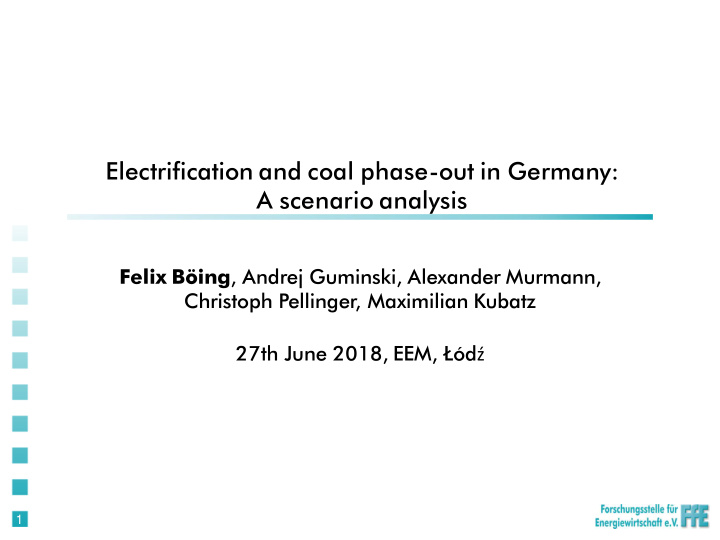



Electrification and coal phase-out in Germany: A scenario analysis Felix Böing , Andrej Guminski, Alexander Murmann, Christoph Pellinger, Maximilian Kubatz 27th June 2018, EEM, Łód ź 1
1. Motivation: Electrification dilemma 2 2 1. Motivation 2. Method 3. Results 4. Conclusion
1. Motivation: Electrification dilemma 2. Method: Energy system modelling What are the energy system effects of a lignite phase-out or an increasing CO 2 -price in a high electrification and high RES scenario? What role do Germany’s neighboring countries play with respect to the procurement of supply security and emissions? What are the operational characteristics and transmission grid repercussions of future peak-load generation units in an electrification regime? Regionalization Electrification / Definition of and calculation of Simulation RES potential Evaluation Scenarios RES-generation analysis for GER and load profiles 3 3 1. Motivation 2. Method 3. Results 4. Conclusion
2. Method: Scenario Analysis Electrification Scenario Reference Scenario [ Ref61 ] [ Elec61 ] no electrification Parameter Unit Value low grid congestion Electrical FEC TWh 180 / 330/ Parameter Unit Value Value (Domestic / Industry / 167 / 28 / 20 SME / Transport / / 34 Year - 2015 2030 DistH / Grid losses) Sum: 759 Electrical FEC TWh 129 / 225 / 150 / 134 / 210 / 110 RES Capacity GW el 15 / 99 / 146 (Domestic / Industry 11 / 1 / 26 / 21 / 1 / 23 (Wind-Offshore / Wind- / SME / Transport / Sum: 542 Sum: 499 Onshore / PV) DistH / Grid losses) RES-Share % 61 €/ Fuel Prices (Oil / 35.9 / 21.8 / 8.8 52 / 29 / 9.5 / Gas / Hard Coal / MWh th / 1.5 1.5 Electrification Scenario Lignite) €/t CO2 CO 2 -Price 7.6 30 [ Elec75 ] Conventional GW el 87 (of which 59 (of which Parameter Unit Value Generation 32.9 coal-fired) 23 Electrical FEC TWh 180 / 330/ Capacities coal-fired) (Domestic / Industry / 167 / 28 / 20 RES Capacity GW el 3.4 / 41.2 / 39.3 15 / 59 / 77 SME / Transport / / 34 (Wind-Offshore / DistH / Grid losses) Sum: 759 Wind-Onshore / PV) RES Capacity GW el 15 / 125 / RES-Share % 33 61 (Wind-Offshore / Wind- 190 Onshore / PV) RES-Share % 75 4 4 1. Motivation 2. Method 3. Results 4. Conclusion
2. Method: Scenario Analysis Electrification Scenarios [Elec61] | [Elec75] German - 9 GW of CO 2 -price lignite-fired increased power plants 30 120 €/t European CO 2 -price increased 30 120 €/t 5 5 1. Motivation 2. Method 3. Results 4. Conclusion
2. Method: Simulation Tool „ ISAaR “ ISAaR: Integrated simulation model for plant dispatch and expansion planning with regionalization European Energy System Model, regional resolution: NUTS3/Communities Grid Model: Transmission grid level, 496 nodes in GER/AT; ~1500 Europe Linearized load flow calculation according to PTDF method; "n-1" safe operation due to a max. AC line loading of 70%. European European grid simulation market simulation Fixed power plant dispatch 1 2 ISAaR simulation sequence Fixed cross-border flows 4 3 GER/AUT grid Fixed generation dispatch GER/AUT congestion market simulation simulation 6 6 1. Motivation 2. Method 3. Results 4. Conclusion
3. Results: Increase of gas-fired generation & higher imports Oil Elec61 Elec75 Lignite 299 Hard Coal 300 300 301 Gas 27 23 37 219 89 218 213 Import 21 223 56 29 199 25 18 29 Export 80 18 47 25 51 115 88 43 157 136 98 139 120 49 118 104 160 93 129 111 104 85 83 78 63 25 -33 -29 -20 -41 -44 -57 -60 -61 -73 Ref61 Elec61 _nl _120 _120_DE Elec75 _nl _120 _120_DE 7 7 1. Motivation 2. Method 3. Results 4. Conclusion
3. Results: High capacity gap but low full load hours 8 8 1. Motivation 2. Method 3. Results 4. Conclusion
3. Results: Emission coefficient of power generation 301 Elec75 Elec61 257 225 212 193 180 177 162 145 42 10 7 2 2 -2 -34 -36 -38 -48 -51 -59 -73 -87 -119 -164 CO 2 -coefficient of German Delta in CO 2 -emissions Delta in CO 2 -emissions power generation in g CO2 /kWh to Ref61 in Mio. t CO2 (GER) to Ref61 in Mio. t CO2 (EU) 9 9 1. Motivation 2. Method 3. Results 4. Conclusion
curtailment (grid congestion simulation) 3. Results: curtailment (market simulation) -14.9 -28.3 Elec75_120 16.8 -3.4 negative redispatch positive redispatch -18.1 -29.9 Elec75_nl 15.4 -3.6 -20.3 -31.5 Elec75 15.5 Redispatch -4.3 (positive) -0.5 Elec61_120 -11.4 13.5 -2.7 Redispatch -0.6 Elec61_nl 13.0 -10.9 curtailment -2.7 (market simulation) -0.6 Elec61 -10.9 13.0 -2.7 curtailment (grid congestion -1.8 simulation) Ref61 -5.7 4.8 -0.9 Curtailment and Redispatch (TWh) 10 10 1. Motivation 2. Method 3. Results 4. Conclusion
4. Conclusion: Electrification dilemma 11 11 1. Motivation 2. Method 3. Results 4. Conclusion
4. Conclusion: Investigated decarbonisation scenarios 12 12 1. Motivation 2. Method 3. Results 4. Conclusion
4. Conclusion: Energy system repercussions 13 13 1. Motivation 2. Method 3. Results 4. Conclusion
4. Conclusion: Overall reduction of CO 2 -coefficient 14 14 1. Motivation 2. Method 3. Results 4. Conclusion
4. Conclusion: Regulatory measures European energy transition Grid expansion Demand and supply-side capacitiy market 15 15 1. Motivation 2. Method 3. Results 4. Conclusion
Thanks for your attention Contact details: Felix Böing, M.Sc. +49 (89) 158121-59 FBoeing@ffe.de Forschungsstelle für Energiewirtschaft e.V./ Research Center for Energy Economics Am Blütenanger 71 80995 München Funded by: Germany www.ffe.de Dynamis Project: www.ffe.de/dynamis FKZ: 03ET4037A 1 16
Recommend
More recommend